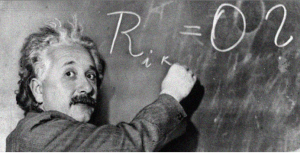This week the South China Morning Post featured an article entitled “Why the theories of Einstein, climate change or evolution can never be proved right”.

Referring to recent world headlines that Einstein’s theory on gravitational waves had finally been proven, the writer, Timothy Wotherspoon, argues that a scientific theory can never been proven right. He explains that a scientific theory is only as good as the result of its last experiment. You see, a scientific theory seeks to predict consequences of future actions including actions not previously observed in scientific experiments. A good scientific theory is one with good prediction ability—such as Einstein’s theory. While we can prove such a theory wrong by setting up a new experiment and demonstrating an example of it not applying as predicted, we can never prove it right. This inability to prove a theory right is essential to the nature of open scientific inquiry and, according to Wotherspoon, the progress of science. If we thought we were right and had proven it, then we would be tempted to just sit back, rest on our laurels, and congratulate ourselves that we now knew everything. Scientific enquiry would stop.
Naturally, this got me thinking … What of scientific enquiry and progress in the mediation field?
Joel Lee’s post this month about movement in mediation and the role of physiology in resolving conflict is a great example of open enquiry in this regard. There is a large body of (neuro-)scientific research indicating that our brain is not a fixed piece of hardware but rather a malleable, adaptive living organ that has the ability to transform its own function and structure. At the heart of this idea of neuroplasticity is the principle that neurons that fire together wire together, while neurons that wire apart, stay apart (Beausoleil and LeBaron 2013). This means that we create patterns and develop habits as we repeat thoughts and behaviours. Over time, these become comfortable superhighways that we drive along without conscious thought. We turn to autopilot as we traverse the well-travelled terrain of neurons that have fired together countless times. These patterns are not easy to shift: in negotiations, such habits of thought lead us down the slippery slope of positional posturing towards blockages and impasse. Yet it is possible to bring movement into the brain.
The ability to create space allowing for movement in the body and the mind is increasingly considered to be an essential aspect of problem-solving. More than this, so connected are brain and body that physical movement has the ability to release us from mental habits when we feel locked in negotiation impasse. For example, taking a walk in a park, across a golf course or in a forest can resonate with us at emotional and unconscious levels, thereby accessing and shifting the neural processes of firing and wiring, referred to previously.
So, what are we doing about it in the mediation field?
While there seems to be a plethora of conference talk about neuroscience and conflict resolution, there seems to be little movement (pardon the pun). Indeed, most of talk—and arguably this blog posting also—is delivered in a way that conforms to the traditional separation of brains and brawn. Joel makes some suggestions in his post and I would like to add to these with two examples from the conflict resolution field. Co-incidentally (or not) both examples are drawn from European experiences.
The first takes place in Norway. Some readers may remember the Oslo negotiation process of the 1990s. The scholars who designed this process chose a remote, rural Norwegian setting. They built into the negotiation process time for walks in the woods and space for contemplation surrounded by natural beauty in order to create a multi-sensory experience for the negotiators. While this intractable conflict still continues, I remember listening to one of the negotiators, Joel Singer, at a conference many years ago, as he highlighted the significant role played by these “non-intellectual” or “non-substantive” elements at the negotiation table.
The next example draws on the practice of systemic constellations, which offers an embodied approach to problem-solving (see, for example, the work of Insa Sparrer). In this process, a person (client) who wishes to gain deep insights into a particularly challenging issue in a negotiation, selects any number of individuals (so-called representatives) to assist in creating a physical constellation that depicts the situation from the client’s perspective. The resulting constellation—the spatial arrangement of the representatives as a whole and the kinaesthetically-felt reactions of the representatives to one another—reproduce the structure and dynamics of the conflict (system) the client is describing. Following the initial placement, a series of interventions may be undertaken to rearrange the spatial scene until the client perceives the new geometrical arrangement as coherent. Finally, the client has time to absorb the rearranged scene, which in turn, can lead to new insights, relationships and actions in relation to the negotiation or mediation itself. One of the fascinating aspects of constellations is the importance of placing physical bodies in relation to each other in space. Increasingly, systemic constellation work is being used in a range of settings including organisational and family conflict resolution.
So the science is out there—ready to be proven wrong. And the practice already exists, although it may not be mainstream—from simple interventions like taking a walk to more complex constellation work.
________________________
To make sure you do not miss out on regular updates from the Kluwer Mediation Blog, please subscribe here.


